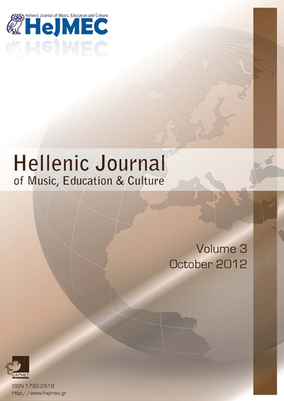Harmony and the Oneness of Opposites: : Teaching Music Theory through Aesthetic Realism
Part of : Hellenic journal of music, education and culture ; Vol.2, No.1, 2011, pages 18-36
Issue:
Pages:
18-36
Author:
Abstract:
With examples from Bach, Chopin, Stravinsky, Ellington, and Monteverdi, this paperprovides an answer to the question: “What is the best way to motivate students to learn musictheory?” By relating it to the questions people face in life! And the most effective, accurate, excitingway to do so is through the Aesthetic Realism teaching method, created by the great American poetand educator Eli Siegel. According to Aesthetic Realism, art and life have in common the Opposites:the very substance of the world and our emotions, and likewise the technical basis of music. AsSiegel explained: “In reality opposites are one; art shows this.” Central technical concepts inharmonic theory are considered in the light of this philosophic idea, and the work of varioustheorists is cited in support of it, including Zuckerkandl, Schönberg, Schenker, and Toch. The essayalso addresses two ethical matters inseparable from effective pedagogy: how to bridge the gapbetween “art and science,” famously described by C.P. Snow, and how to recognize the temptation,for student and teacher, alike, to establish our personalities on the basis of contempt rather thanrespect—a danger Eli Siegel did more to unearth and explicate than any previous educator.
Subject:
Subject (LC):
Keywords:
Eli Siegel; Music Theory; Music Pedagogy; Aesthetic Realism; Harmony; Art and Life, Eli Siegel, Music Theory, Music Pedagogy, Aesthetic Realism, Harmony, Art and Life
References (1):
- Austin, W. (1966). Music in the Twentieth Century. New York: W. W. Norton & Company.Brown, M. (2005). Explaining Tonality: Schenkerian Theory and Beyond. Rochester: University of RochesterPress.Cooke, D. (1959). The Language of Music. Oxford: Oxford University Press.Erickson, R. (1960). The Structure of Music: A Listener‟s Guide. New York: Noonday Press.Green, E. (2005a). Donald Francis Tovey, Aesthetic Realism, and the Need for a Philosophic Musicology /Donald Francis Tovey, estetiƒçki realizam i potreba za filozofijskom muzikologijom. International Reviewof the Aesthetics and Sociology of Music, 36(2), 227-248.Green, E. (2005b). A Note on Two Conceptions of Aesthetic Realism. The British Journal of Aesthetics, 45(4),438-440. doi: 10.1093/aesthj/ayi053Green, E. (2006). Biography as Ethics: The Battle Between Contempt and Respect in the Mind of FelixMendelssohn. International Review of the Aesthetics and Sociology of Music, 37(2), 157-166.Green, E. (2007). Meeting the New: What 21st Century Educators Can Learn from the Earliest'Ethnomusicologists' about the Appreciation of Music. Journal of Historical Research in Music Education,29(1), 39-54.Green, E., & Perey, A. (2004). Aesthetic Realism: A New Foundation for Interdisciplinary Musicology. Paperpresented at the Conference on Interdisciplinary Musicology (CIM04), Graz/Austria.Green, E., & Shapiro, A. (2006). Music of Every Culture Has Something in Common and Can Teach Us aboutOurselves: Using the Aesthetic Realism Teaching Method. In C. Frierson-Campbell (Ed.), Teaching Musicin the Urban Classroom (Vol. 1). Lanham, MD: Rowman & Littlefield Education.Hyers, M. C. (1973). Zen and the Comic Spirit. Philadelphia: The Westminster Press.Kranz, S. (Ed.). (1969). Aesthetic Realism: We Have Been There. Six Artists on the Siegel Theory of Opposites.New York: Definition Press.Perey, A. (1973). Oksampmin Society and World View. PhD, Columbia University, New York.Perey, A. (1976). The Aesthetic Realism of Eli Siegel as a Teaching Method in Anthropology. Anthropology &Education Quarterly, 7(4).Perey, A. (2005). Gwe: Young Man of New Guinea New York: Waverly Place Press.Randall, D. (Ed.). (1986). The New Harvard Dictionary of Music. Cambridge, MA: Belknap Press.Sahasraduhne, P. (2003). International Conversations Through Art: Art Education for the New Millennium.Paper presented at the 31st InSea World Congress, New York: Center for International Art Education,Teachers College, Columbia University.Schenker, H. (1973). Harmony (E. M. Borgese, Trans.). Cambridge, MA: The MIT Press.Schönberg, A. (1983). Theory of Harmony (R. E. Carter, Trans.). Berkeley: University of California Press.Schönberg, A. (1995). The Musical Idea and the Logic, Technique, and Arts of its Presentation. New York:Columbia University Press.Shapiro, A. (2010). Studying Multicultural Music Can Oppose Prejudice: The Aesthetic Realism TeachingMethod Shows How. In M. C. Moore & P. Ewell (Eds.), Kaleidoscope of Cultures: A Celebration ofMulticultural Research and Practice: Proceedings of the MENC/University of Tennessee NationalSymposium on Multicultural Music. Lanham, MD: Rowman & Littlefield Publishers, Inc.Siegel, E. (1955). Is Beauty the Making One of Opposites. The Journal of Aesthetics and Art Criticism, 14(2).Siegel, E. (1969). Art as Life. In S. Kranz (Ed.), Aesthetic Realism: We Have Been There. Six Artists on the SiegelTheory of Opposites. New York: Definition Press.Siegel, E. (1981). Self and World: An Explanation of Aesthetic Realism. New York: Definition Press.Siegel, E. (1997). The Modern Quarterly Beginnings of Aesthetic Realism: 1922-1923. New York: DefinitionPress.Simpson, J. A., & Weiner, E. S. C. (Eds.). (1991). The Oxford English Dictionary (2nd ed. Vol. 6). Oxford:Clarendon Press.Slonimsky, N. (1989). Lectionary of Music. New York: McGraw Hill.Snow, C. P. (1998). The Two Cultures. Cambridge, MA: Cambridge University Press.Toch, E. (1977). The Shaping Forces in Music: An Inquiry into the Nature of Harmony, Melody, Counterpointand Form. New York: Dover Publications.van der Merwe, P. (2004). Roots of the Classical: The Popular Origins of Western Music Oxford: OxfordUniversity Press.Zuckerkandl, V. (1971). The Sense of Music. Princeton: Princeton University Press.Zuckerkandl, V. (1973). Sound and Symbol: Music and the External World (W. R. Trask, Trans.). Princeton:Princeton University Press.Zuckerkandl, V. (1976). Man, the Musician. Princeton: Princeton University Press.




